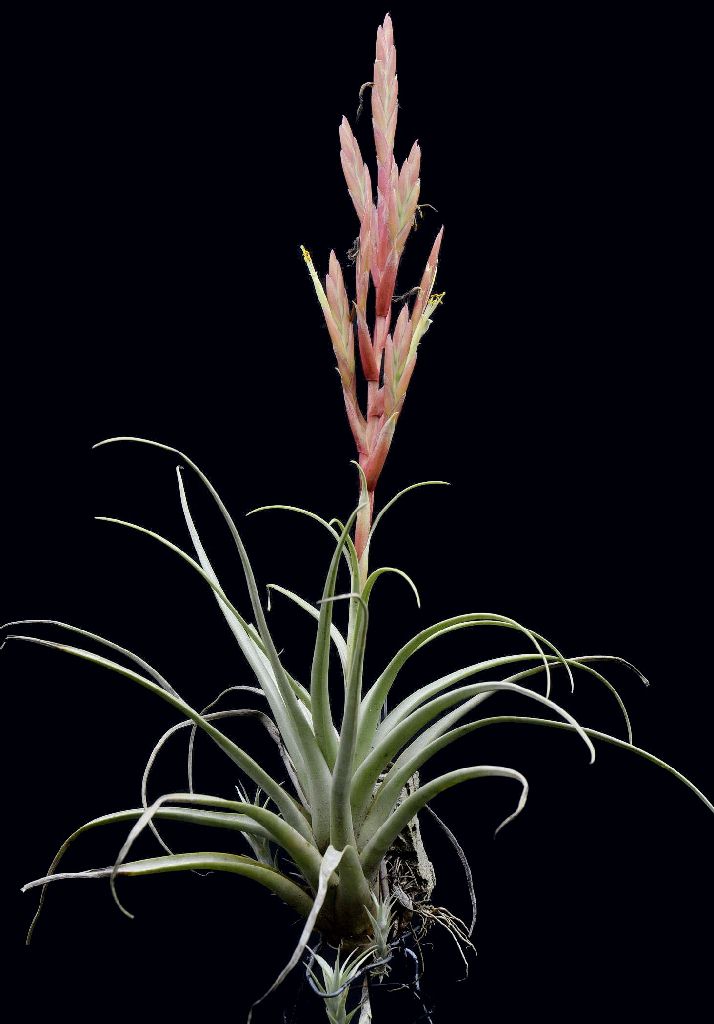
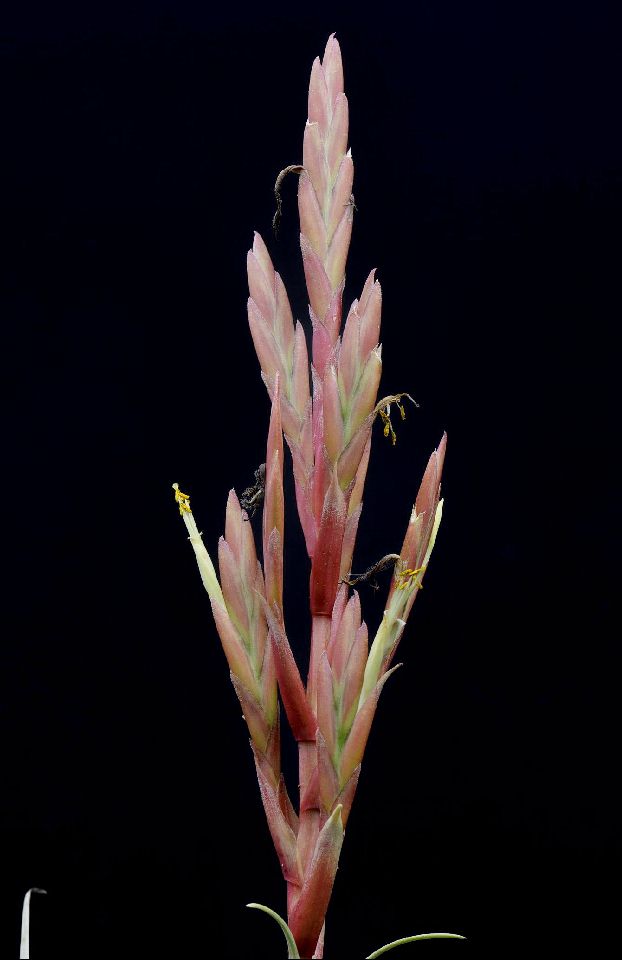
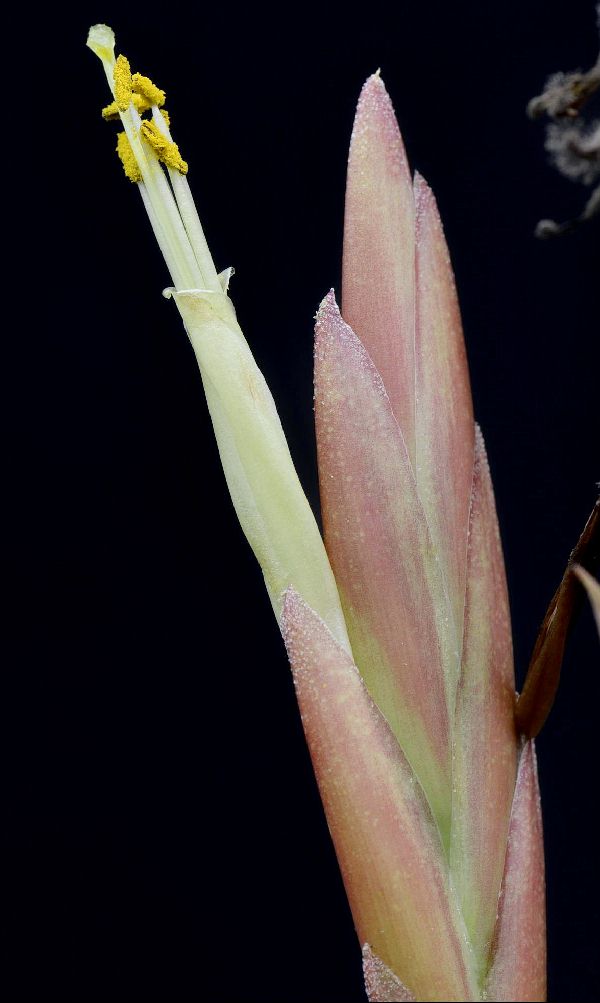
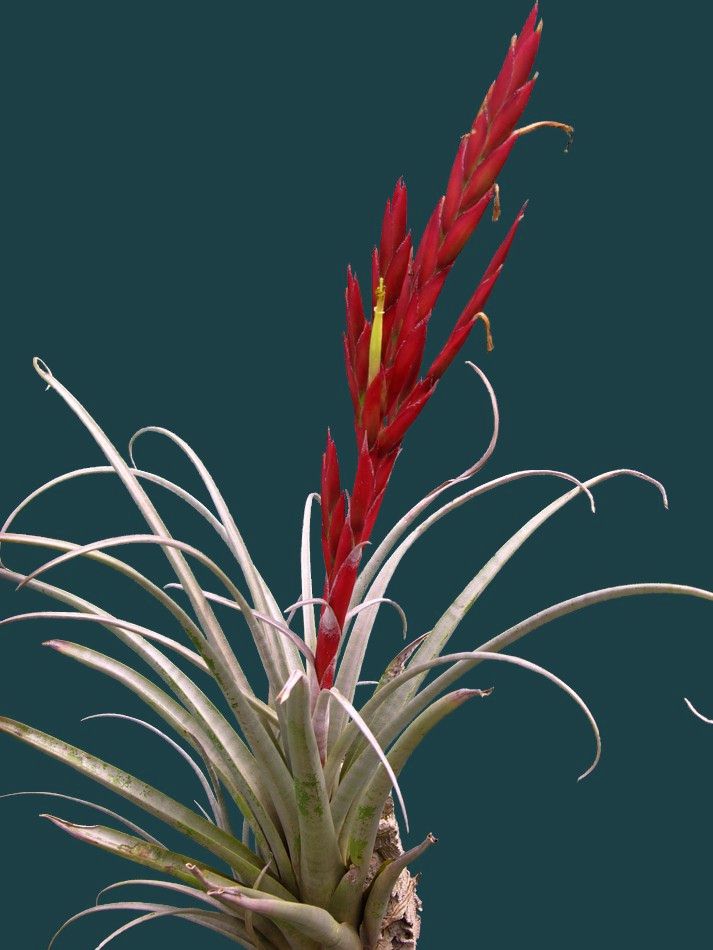
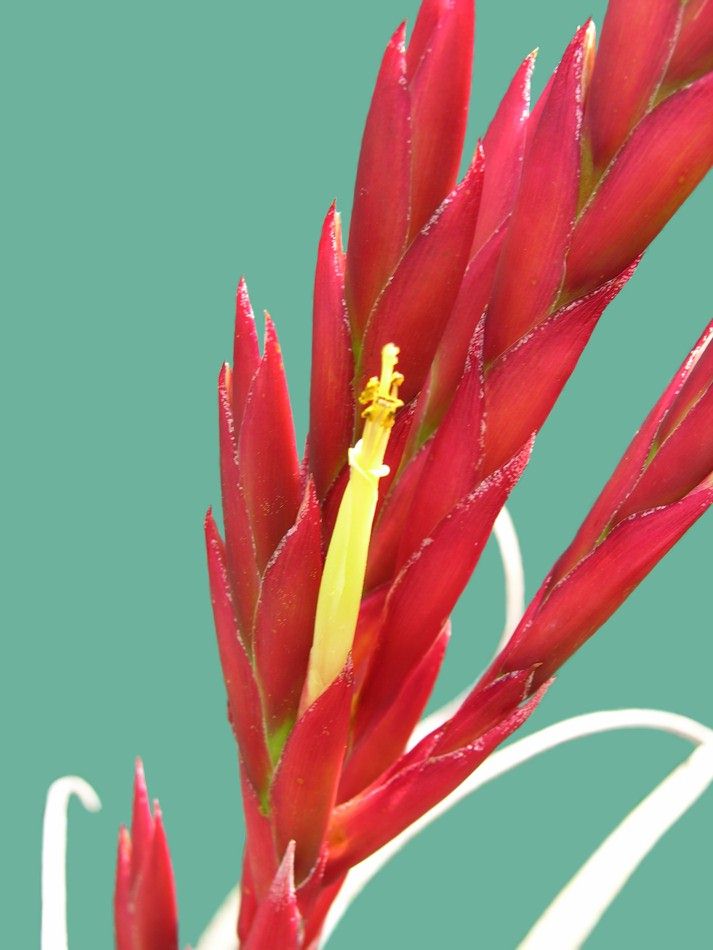
Pflanze stammlos, aber mit kurzen Stolonen (Abb.22a) und stark wurzelnd, bluhend bis 45 cm hoch. Rosettenblatter zahlreich, eine bis 25 cm hohe und 40 cm breite Rosette bildend. Scheiden ± deutlich, bis 4 cm lang, 3,5 cm breit, breit-oval, dunkelbraun, beiderseits lepidot. Spreite schmal-3-eckig, attenuat, bis 30 cm lang, oberhalb der Scheide 2,5 cm breit, an der Basis mit etwas aufgebogenen Randern, dicht grau lepidot, schwach gebandert, unterseits carinat, aufrecht bis ubergebogen. schaft grun, rund, bis 20 cm lang. Schaftbrakteen dicht imbrikat, die basalen subfoliat, die oberen mit langer, rotlich-brauner Scheide und kurzer, zuruckgebogener spreite. Infloreszenz locker bipinnat, bis 28 cm lang und 4 cm breit, mit 4-6 aufrechten Ahren (Abb. 22, links, Abb. 22a links). Infloreszenzachse grun, kahl, etwas kantig. Ahren bis 14 cm lang, 2 cm breit, mit 2,5 cm langer, steriler, beblatterter Basis, complanat, mit 8-10 Bluten. Primarbrakteen kurzer als die Ahren, aufrecht, langlich-lanzettlich-zugespitzt, bis 4 cm lang, 1,5 cm breit, rotlich-braun, zerstreut lepidot. Florale Brakteen imbrikat, die 4-kantig abgeflachte, grune Rhachis z.z. der Anthese wenig sichtbar (postfloral deutlich sichtbar), aufrecht, carinat, mit gerader Spitze, bis 35 mm lang, 1,5 mm breit, grun, an der Spitze rot, unterseits zerstreut, oberseits dichter lepidot, die Sepalen meist etwas uberragend (Abb. 22, rechts). Bluten subsessil, bis 5 cm lang, aufrecht. Sepalen 28-30 mm lang, schmal-lanzettlich, zugespitzt, die hinteren carinat, grun, bis zum Grunde frei. Petalen schmal-lineal, an der Spitze etwas zuruckgebogen, eine enge, blass gelblich-grune Rohre bildend. Staubblatter herausragend, mit weissen Filamenten und gelben Pollensicken, vom Griffel mit den grunen Narben uberragt (Abb. 22, rechts).
Holotypus: B.G.H. 66 720, leg. Wayne Schuster, Chula Vista, Calif. (Mai 1984), im Herb. Inst. System. Bot. Univ. Heidelberg (HEID).
Heimat und Verbreitung: Steile Felswande bei 1300-1500 m, bei Nacaltepec (Estado Oaxaca), Mexiko.
T. schusteri, nach ihrem Entdecker Wayne Schuster (Chula-Vista, Kalifornien)
benannt, ist mit ihren dicht silbergrau lepidoten, an der Basis haufig etwas quergebanderten und unterseits ± deutlich gekielten Blattspreiten, den steif aufrechten Ahren und gelbgrunen Bluten eine sehr dekorative Pflanzen, die in den Verwandtschaftskreis von T dugesii Baker und T rodrigueziana Mez gehort; beide kommen gleichfalls in Sudmexiko (Oaxaca) vor.
Die Unterschiede von T. schusteri zu T. dugesii sind die folgenden: Infloreszenzen nicht dicht zylindrisch, sondern locker und wenig-ahrig; florale Brakteen nicht alat-carinat, an der Spitze nicht kahl und glanzend, sondern matt und zerstreut lepidot; Sepalen bis zum Grunde frei und nicht hoch verwachsen; Petalen gelblich-grun, nicht blau-violett. Zudem ist T. schusteri kleiner, nur bis 45 cm hoch und bildet (nach Beobachtungen von P. Koide) an der Basis mit kurzen Stolonen versehene Innovationstriebe (Kindel; Abb. 22a, rechts).
Von T. rodrigueziana unterscheidet sich T. schusteri in folgenden Merkmalen:
Pflanze kleiner als 1 m; Infloreszenz aufrecht, nicht an der Spitze ubergebogen;
florale Brakteen an der Spitze nicht cucculat, sondern zugespitzt und zerstreut lepidot; Sepalen frei und nicht bis zur Halfte verwachsen; Petalen grunlich-gelb.
In der Original-Diagnose von Mez (Repert. Spec. Nov., 16, 73, 1919) werden leider keine Angaben uber die Blutenfarbe von T. rodrigueziana gemacht; nach eigenen Beobachtungen bluht diese violett.
Bemerkenswert fur T. schusteri ist, dass das Langenverhaltnis von floralen Brakteen zu Sepalen an einer Ahre variiert. Letztere sind meist etwas kurzer als die floralen Brakteen; sie konnen aber auch gleichlang oder sogar langer sein. Im frischen Zustand bedecken die floralen Brakteen, die in der Kultur gelblich-grun bis schwach rot, am Standort vermutlich aber lebhafter gefarbt sind, die Rhachis
vollig; postfloral und an herbarisiertem Material hingegen ist diese sichtbar. Zudem sind die im frischen Zustand glatten floralen Brakteen getrocknet stark genervt und besitzen einen hyalinen, undulaten Rand. Nach Angaben von P. Koide wachsen in der naheren Umgebung von T. schusteri auch die gelbbluhende T. bourgaei Baker und die violettbluhende T. rodrigueziana Mez. Dennoch durfte es sich bei T. schusteri nicht um eine Hybride zwischen beiden handeln.
Desc from J Brom Soc. 38: 214-5. 1988
Plant stemless, but with short stolons, flowering up to 45 cm high.
Leaves form a 25-cm high and 40-cm wide rosette.
Sheaths more or less conspicuous, up to 4 cm long, 3.5 cm wide, dark brown, lepidote on both sides.
Blades narrow triangular , attenuate, up to 30 cm long, 2.5 cm wide above the sheaths, densely gray lepidote, slightly banded, carinate below, erect to recurved.
Scape erect, green, round, up to 20 cm long.
Scape bracts imbricate, the basal ones subfoliate, the up¬per with a long, reddish brown sheath and a short, recurved blade.
Inflorescence laxly bipinnate, up to 28 cm long and 4 cm wide, with 4-6 erect spikes.
Inflorescence axis green, glabrous, somewhat angled.
Spikes up to 14 cm long, 2 cm wide, with a sterile, foliate, 2.5-cm long base, complanate, with 8 to 10 flowers.
Primary bracts shorter than the spikes, erect, long-lanceolate, attenuate, up to 4 cm long, 1.5 cm wide, reddish brown, sparsely lepidote.
Floral bracts imbricate, erect carinate, 35 mm long, 15 mm wide, green, apex red, sparsely lepidote beneath, densely lepidote above, slightly exceeding the sepals.
Rachis 4-angled, green, at anthesis hardly visible (post floral clearly visible).
Flowers subsessile, 5 cm long, erect.
Sepals 28-30 mm long, narrow-lanceolate, attenuate, the posterior carinate, green, free.
Petals narrow-linear, their blades somewhat recurved, forming a narrow, yellow-green tube.
Stamens exserted, style with green stigmas, exceeding the stamens.
Holotype: B.G.H. 66720, leg. Wayne Schuster, Chula Vista, California (May 1984), in Herb. Inst. System. Bot. Univ. Heidelberg (HElD).
Notes translated by Butcher
T. schusteri, named after its discoverer Wayne Schuster, Chula-Vista, California, is densely silver-grey lepidote, at the base abundant with some cross banding and underneath ± clearly keeled leaf blades, the stiffly upright spike and yellow green flowers make this a very ornamental plant, that belong to the complex of T. dugesii Baker and T. rodrigueziana Mez; both occurring in south Maxico (Oaxaca) likewise.
The differences of T. schusteri from T. dugesii are the following:
Inflorescence not densely cylindric but lax and few spiked;
floral bracts not alate-carinate, at the top not glabrous and shiny but weak and scattered lepidote;
Sepals free from the base and not high connate;
Petals yellowish green, not blue-violet.
Moreover, T. schusteri is smaller, only to 45 cm high and forms, (after observations of P. Koide), at the base, short stolon equipped adventitious offsets; (fig. 22a, right).
From T. rodrigueziana, T. schusteri differs in following characteristics:
Plant smaller than 1 m;
Inflorescence upright, not bent over at the top;
floral bracts at the top not cucullate but acuminate and scattered lepidote;
Sepals free and not connate up to half;
Petals greenish yellow.
In the original diagnosis by Mez (Repert. Spec. Nov, 16, 73, 1919) there were unfortunately no statements made about the flower colour of T. rodrigueziana; from our observations the flowers are violet.
Remarkably for T. schusteri is the variation of length ratio of floral bracts to the sepals on the spike. The latter are usually somewhat shorter than the floral bracts; however they can also be equally long or even longer than. The floral bracts in a fresh condition, in culture are yellowish green to weak red, but at location are lively coloured, the Rhachis both at postfloral and as herbarium material is fully visible. The floral bracts when fresh are smooth but when dried are strongly nerved and have a hyaline, undulating edge.
According to statements from P. Koide growing in the near vicinity to T. schusteri you also find the yellow flowering T. bourgaei Baker and the violet flowering T. rodrigueziana Mez. Nevertheless it is not considered that T. schusteri is a hybrid between both.